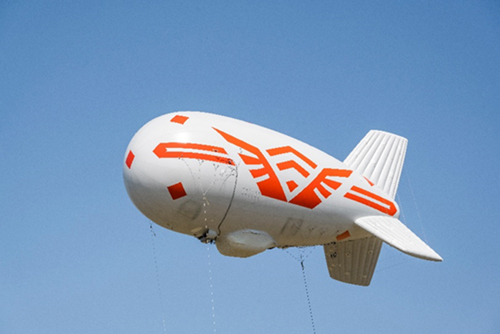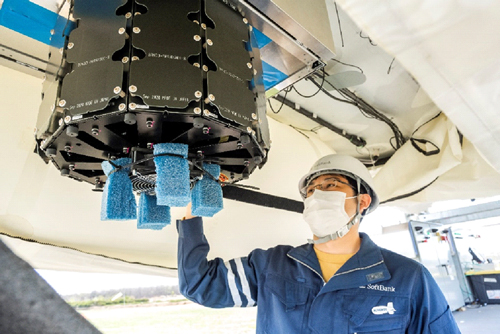Softbank, continuing its interest in high-altitude communications, says it has successfully tested a tethered autonomous aerostat during a field trial in Japan.
Working with U.S.-based Altaeros Energies (in which Softbank is an investor), the two companies say they “achieved stable and wide-area network coverage” with the tethered blimp during testing at Hokkaido Spaceport, Taiki Town in Hokkaido, Japan, in May.

The test relied on an autonomous tethered aerostat from Altaeros, outfitted with a Softbank base station and proprietary cylindrical, multi-element phased array antenna. The tech, Softbank noted, was developed by both Softbank and its subsidiary HAPSMobile.
Compared to an older iteration of the aerostate-based system, Softbank said that the new system “was operable at higher altitudes and carried heavier communication payloads, and it also achieved wider area network coverage with greater communication stability during the trial.”
The aerostat was tethered at a height of 249 meters, and Softbank reported that under good line-of-site conditions within a “few tens of kilometers”, it verified that the test achieved “stable connectivity” in which no mobile device handovers occurred and signal reception levels were steady, even when there were changes in the altitude or orientation of the blimp because due to the wind.
In other test news:
-Chinese third-party test house World Standardization Certification & Testing Group (WSCT) will be using Keysight Technologies‘ 5G test solutions to certify 5G mobile devices, as well as to test European Union E112 caller location capabilities to comply with EU regulations.
Keysight also announced this week that Italian certification service company Azcom Technology is using its Keysight Open Radio Architect (KORA) solutions to test Open Radio Access Network radio and distributed units and confirm specification conformance and interoperability.
In addition, the company also reported that its Pathwave RFPro solution, integrated into Synopsys’ Custom Compiler design offering, supports chipmaker TSMC’s newest N6RF reference design. Keysight says that it and Synopsys developed the example custom design with the capability to perform integrated electromagnetic (EM) analysis and custom radio frequency (RF) device modeling in Keysight PathWave RFPro. Keysight also contributed to detailed application notes for implementation.
“Integrated EM simulation is needed for verification and optimization of the parasitic effects found in today’s multi-technology RF designs. Iterative EM-circuit co-simulation helps designers ensure first-pass success and this interoperability achievement is a testimony to the collaboration between TSMC, Synopsys and Keysight,” said Niels Faché, VP and GM of Keysight’s PathWave software solutions.
-Japanese operator NTT DoCoMo will use Viavi Solutions’ test suite for end-to-end testing for its 5G Open RAN Ecosystem (OREC), a project launched in 2021 that is comprised of 13 vendor partners. According to Viavi, its test suite will ensure that NTT DoCoMo can support the requirements of multiple international operators to participate in 5G Open RAN testing. Full story here.
-Product engineering and manufacturing company VVDN (Voice, Video, Data, Network) said this week that it has plans to expand its operations in Europe, with a goal of bringing in $500 million in new revenues from the region. Nitin Jain, the company’s VP of business development for 5G and data centers in Europe said, “We see Europe 5G market as a huge growth potential. With VVDN’s strong foothold in the 5G design, testing services offerings on oRAN [radio units] and [distributed units] along with our fronthaul, L1 Low PhY and High PHY IP’s, we can help guide OEMs, telcos, test & measurement companies through the complexity of 5G product design, development and manufacturing.”
The company also opened a new 5G test lab in India earlier this year focused on Open RAN radio units.
–NI said recently that it has patented a new measurement technique that it says provides best-in-class error vector magnitude (EVM) performance for Wi-Fi signals, improving upon both accuracy and measurement speed to enable device manufacturers to guarantee specification compliance for Wi-Fi 7 (802.11be) and get products to market faster.
“One of the most challenging RF performance measurements of new WiFi7 designs is the EVM measurement over wide RF bandwidth,” NI said. Its patented measurement technique relies on the use of two NI vector signal transceivers and “utilizes cross-correlation signal processing to improve measurement accuracy and achieve Wi-Fi 7 performance specifications” while reducing the amount of time it takes to perform the extremely high dynamic range, wide bandwidth measurements.
–US Cellular and Ericsson have begun testing the performance of the carrier’s 5G network at altitude using drone technology. The trials involved flying a drone outfitted with a 5G smartphone and RF measurement equipment between two of US Cellular’s commercial 5G towers in Beloit, Wisconsin. Read more in this story.

